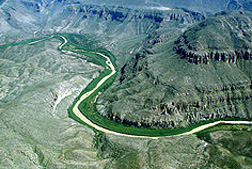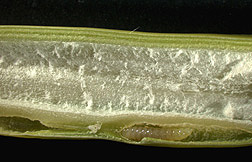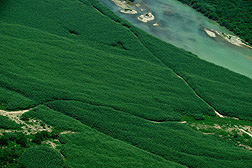Biocontrol Battle Begins Against Giant Reed (Arundo)
|
|
In the Southwest, an exotic and invasive weed of riparian habitats and irrigation canals has become an absolute monster.
In its native Spain, Arundo donax, or giant reed, is kept under control by a host of insects. But that’s not the case here in the United States, where the invader competes for scarce water resources, thereby harming native plants and hindering farmers’ ability to produce crops.
“Whole riparian forests have been displaced by Arundo, and you rarely see birds or any wildlife in these dense patches of the weed,” says John Goolsby, an entomologist at the Agricultural Research Service’s Beneficial Insects Research Unit (BIRU) in Weslaco, Texas.
“The most devastating impacts of Arundo are along the Rio Grande in Texas,” says Goolsby, who’s spearheading ARS’s efforts to manage the weed. But Arundo’s effects are also felt south of the border, where the reed has led to the extinction of a rare fish species near Monterrey, Mexico.
The Weslaco laboratory is located at the heart of the Arundo problem. But it also is the epicenter of hope for a solution.
|
|
A Fantastic Foursome
After making multiple trips to Spain to work with scientists there, and after testing various insects to see if they’re host-specific, Goolsby and colleagues have identified four very promising biological controls that could curb the impact of the destructive reed.
The candidate insects would complement existing control methods, such as cutting the cane and applying herbicide.
Each of the four attacks the reed at a different place. A scale insect, Rhizaspidiotus donacis, which may be released this summer, attacks the root. The Tetramesa romana wasp attacks the main stem. This weakens the plant, lessens its overall height, and causes it to form galls and put out side shoots. The Arundo fly (Cryptonevra spp.) eats the inside of new shoots, while the leaf sheath miner, Lasioptera donacis, destroys leaves.
|
|
The wasp—which is harmless to humans—was released earlier this year.
But the scale insect is the biological control that shows the most promise. It feeds on the part of the plant known as the “rhizome,” where most of the plant biomass originates. Debilitating the rhizome could have a big impact on the plant’s growth and spread.
Another benefit: an adult female scale can produce 100 to 200 young. “This outstanding reproductive capacity demonstrates the insect’s potential to establish large and long-lived populations on giant reed,” Goolsby says.
The work builds upon research done earlier by former ARS European Biological Control Laboratory scientists Alan Kirk and Rouhollah Sobhian and by Ray Carruthers of the ARS Exotic and Invasive Weeds Research Unit.
Helping out with Goolsby’s efforts at Weslaco is entomologist Patrick Moran, who has documented the traits, or biologies, of the candidate agents. This information is combined with the host-specificity data—research that Goolsby conducted—to form the basis for petitioning USDA’s Animal and Plant Health Inspection Service for permits to release these biological control agents.
“It’s a monumental project for our research unit,” says John Adamczyk, research leader for BIRU. “But this is a sustainable approach that will spread and exist in the environment for many years to come.”
America’s Arundo: Observations From 16 States
|
|
During the past several years, ARS ecologist David Spencer’s trips around the nation to study Arundo have taken him to nearly every state that the plant has invaded. From a carefully tended Arundo plant growing in the pleasant front yard of an Arkansas home, to dense stands alongside a dirt irrigation ditch in New Mexico, Spencer has studied Arundo’s adaptability to an impressive array of ecosystems. His survey is likely the most comprehensive of its kind for this weed in this country.
Spencer is with the ARS Exotic and Invasive Weeds Research Unit in Davis, California. His ventures included collecting soil samples for analysis by teammate Robert Blank, with the unit’s Reno, Nevada, contingent, and collecting leaf specimens for DNA analysis by coinvestigator Marie Jasieniuk, with the University of California-Davis.
Blank’s analyses of the types of soils Arundo grows on might reveal whether some are less favorable for the plant than others. Blank expects to have results later this year.
Meanwhile, Jasieniuk’s assays of Arundo’s leaves strongly suggest that, in America, the reed doesn’t have much genetic diversity. Subsequent studies by Jim Manhart, Alan Pepper, and Daniel Tarin at Texas A&M University-College Station, in collaboration with ARS, confirmed this finding and more precisely pinpointed the geographic origins of U.S. Arundo populations.
Arundo’s low level of diversity is bad news for the plant, but good news for those who want to stop its spread. “Plants with a relatively narrow genetic base are thought to be less able to adapt quickly to unfavorable environmental changes,” says Spencer.
In this instance, those changes could include attack by any one of the four biocontrol agents—the wasp, scale, fly, or leaf sheath miner.
The ARS-university studies are the first to examine Arundo’s genetic diversity in such detail.
Arundo, Animated
|
This short clip shows a virtual growth model of the invasive weed species Arundo donax, constructed using L-systems modeling. Courtesy of ARS Exotic & Invasive Weeds Research Unit. |
Also a first of a kind: the “virtual Arundo” plant that Spencer has created. In this realistic, computerized animation, an Arundo plant emerges from a thick rhizome and grows on the computer screen to about 30 feet in height.
This simulation is based on a growth model, developed from thousands of measurements of dozens of Arundo plants growing in experiments at Davis and in natural settings. The measurements, taken with a magnetic sensor, are processed using two different software programs.
The virtual plant can be the basis of virtual experiments in which changes in the plant’s environment can be simulated, studied, and used to predict the possible outcome of real-world Arundo experiments.
The on-screen plant could be used, for example, to estimate how much water Arundo plants guzzle, based on the size and quantity of the virtual Arundo’s leaves. Accurate measurements of the weed’s thirst indicate how much water might—if Arundo were brought under control—be freed up for cottonwoods, willows, and other native plants, as well as for fish and wildlife, farms, homes, offices, and factories downstream. Those estimates can be used, in turn, to calculate the cost-effectiveness of Arundo control projects.
Much remains to be learned about Arundo. But the animated Arundo plant, the DNA analyses, the soil studies, and the biocontrol investigations are unlocking some of the plant’s secrets, giving scientists and streamkeepers alike new knowledge that they can use to stop the advance of this aggressive invader.—By Alfredo Floresand Marcia Wood, Agricultural Research Service Information Staff.
This research is part of Crop Protection and Quarantine, an ARS national program (#304) described on the World Wide Web at www.nps.ars.usda.gov.
To reach the scientists mentioned in this article, contact Alfredo Flores, USDA-ARS Information Staff, 5601 Sunnyside Ave., Beltsville, MD 20705-5129; phone (301) 504-1627, fax (301) 504-1486.
"Biocontrol Battle Begins Against Giant Reed (Arundo)" was published in the July 2009 issue of Agricultural Research magazine.










